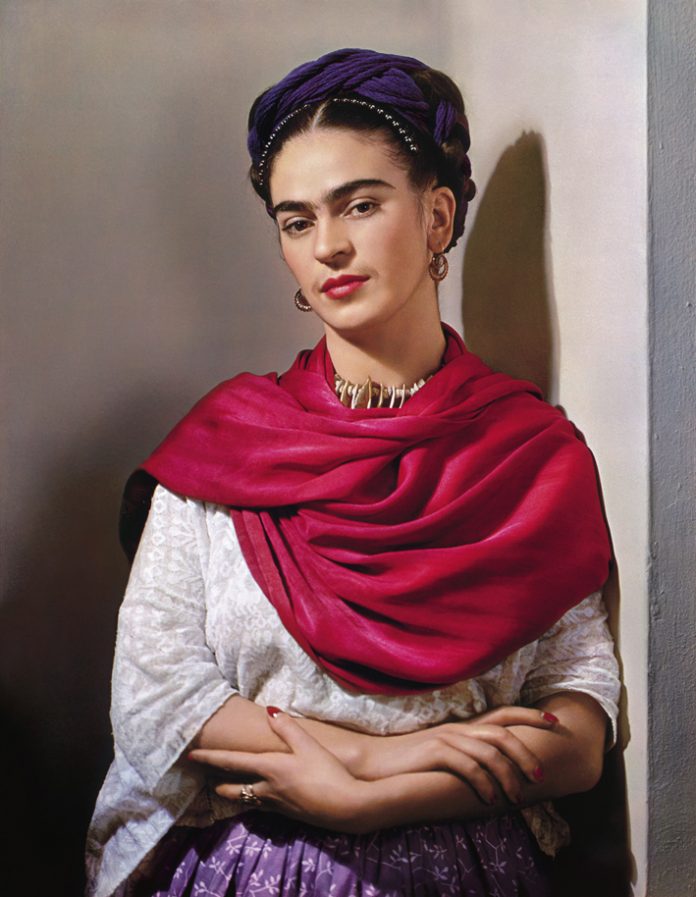Frida Kahlo: Making Her Self Up
Victoria&Albert Museum, Cromwell Road,London SW7 2RL
16 June – 4 November 2018
Admission £15 (concessions available).
SOLD out to the end of this month, the V&A is presenting an exhibition exploring the life and art of Frida Kahlo (b. 1907), one of the most significant artists and women of the 20th century, and how she fashioned her identity.
Frida Kahlo: Making Her Self Up is the first exhibition outside of Mexico to display her clothes and intimate possessions, reuniting them with key self-portraits and photographs to offer a fresh perspective on her compelling life story.
Frida Kahlo de Rivera (July 6, 1907-July 13, 1954) was born Magdalena Carmen Frida Kahlo y Calderón; she was inspired by the 1910-1920 Mexican Revolution and joined the Mexican Communist Party in 1927, where she met her husband the muralist Diego Rivera. She painted many portraits, self-portraits, and works inspired by the nature and artifacts of Mexico, employing a naïve folk art style to explore questions of identity, postcolonialism, gender, class, and race in Mexican society.
Her paintings often had strong autobiographical elements and mixed realism with fantasy.
Born to a German father and a mestiza mother, Kahlo spent most of her childhood and adult life at her family home in Coyoacán, La Casa Azul (The Blue House), now known and publicly accessible as the Frida Kahlo Museum.
She was left disabled by polio as a child, and at the age of eighteen was seriously injured in a traffic accident which caused her pain and medical problems for the rest of her life. Kahlo empowered herself through her art and dress after suffering the devastating near-fatal bus crash which rendered her bed-bound and immobilised for protracted periods of time.
Self-portraiture became the primary focus of her art at this point and she began to paint using a mirror inset into the canopy of her four-poster bed. Kahlo and Rivera were married in 1928, and remained a couple until Kahlo’s death. The relationship was volatile due to both having extramarital affairs; and while they divorced in 1939, they remarried the following year.
The V&A exhibition opens with a section Roots which shows early black and white photos of her and her German father and Mexican mother, and an early self portrait. A section Art and Revolution shows Rivera and his murals and an early oil painting Pancho Villa and Adelita influenced by Cubism and de Chirico and featuring the Mexican revolutionary general.
Here also is a stlll life titled The Bride Who Becomes Frightened When She Sees Life Opened, 1943, featuring melons, a hedgehog and a small bird. Also here is a black and white photo of Kahlo and Rivera at the front of the 1929 May Day parade.
Following this is a short film featuring Kahlo, Rivera, Russian revolutionary leader Leon Trotsky and his wife Natalia at Coyoacan, with Trotsky giving his address to the Mexican people in 1937 thanking the Mexican government for giving him asylum and denouncing Stalin’s trial. This is the exhibition’s only reference to Trotsky’s stay at Coyoacán where he was murdered in 1940 by Stalinist agent Ramon Mercader.
The V&A proceeds with a section Gringolandia with a Kahlo self-portrait on the Mexico-US border of 1932. There is an impressive surrealist painting depicting Mexican rural vs US manufacturing economies.
Working in close collaboration with Museo Frida Kahlo, the V&A displays more than 200 objects from the Blue House. Kahlo’s personal items including outfits, letters, jewellery, cosmetics, medicines and medical corsets were discovered in 2004, 50 years after being sealed in the Blue House by her husband Diego Rivera. Much more was understood about Kahlo’s accident after the discovery of the objects in the Blue House.
A highlight of the exhibition is the resplandor, a lace headdress worn by the women of the matriarchal society from the Ishmus of Tehuantepec region in Southern Mexico, paired with a self-portrait of Kahlo wearing it.
There are examples of intricately hand painted corsets and prosthetics. Her vividly-coloured cosmetics are striking in the celebrated portraits by photographer Nickolas Muray which show her smiling and wearing many of the distinctive Tehuana garments on display.
Kahlo’s self-portraits are more severe and show a woman with a steely determination. In one dramatic Self Portrait With Monkeys, 1943, Coyoacán, she depicts herself and surrounding monkeys looking rather surprised, if not shocked. As well as a display of her beautiful Mexican folklore-inspired dresses, is a moving Magical realist painting The Love Embrace of the Universe, the Earth (Mexico), Me, Diego, Senor Xolotl, 1949, Coyoacán, where she depicts Rivera as a babe in arms.
Kahlo used her striking appearance as a political statement, crafting her identity to reflect her own mestizo (mixed-race) identity and allegiance to Mexican identity.
Mexico flourished in the 1920s and 1930s as a liberal destination that attracted foreign artists, writers, photographers and documentary film makers, in what became known as the Mexican Renaissance. The V&A also shows photographs of traditions in clothing, architecture and the popular arts taken by Edward Weston and Tina Modotti in the 1920s that made an imprint on the Mexican imagination and its perception abroad.
